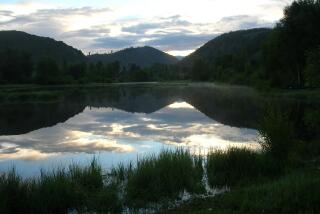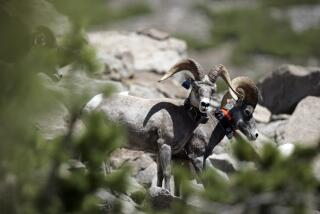Commissary Ridge : To Henry Old Coyote, as for His Crow Ancestors, the Bighorn and Pryor Mountains Remain a Storehouse of Life
- Share via
Among the Crow Indians of Montana, Henry Old Coyote is often a representative in matters that require a spokesman. In the early 1970s, Henry was filling such a role as an emissary from the Crow Indian tribe to the National Park Service, where he served as a liaison between the tribe and the Bighorn Canyon National Recreation Area.
It was my good fortune to get to know Henry during that time and to hear his stories about a multitude of things that usually included how the Crow Indians lived in the past and how they live in the present. With a group of students, I was completing a project in the Bighorn Mountains and Pryor Mountains on land administered by the National Park Service, the Bureau of Land Management, the National Forest Service and the Crow Indian tribe. Our task was to walk over the land, find the remnants of former Indian campsites or other evidence of past activities, and record these locations. Henry Old Coyote helped us tremendously. He would tell us to watch for a certain location where he knew of a former site. If he did not know any specific locations, he offered other clues, such as telling us the landscape would have once been a good area for bison and to watch for evidence of former hunting sites.
On one expedition, we were showing a group of federal land managers the sites found during the summer. Henry was along, but he was staying out of the explanation for each site as we visited it.
We stopped on the side of East Pryor Mountain, at a long, linear ridge confined by two canyons. Named Commissary Ridge, it terminates abruptly at its western end in the junction of the canyons. The canyons are sheer-sided, with drops of several hundred feet to their bottoms, and the lower end of Commissary Ridge is actually a peninsula of broken limestone cliffs that ends in a sheer canyon drop. A bison skull was found on this constricted point. Excavation revealed the remnants of seven bison that had been killed and butchered by hunters from a Stone Age culture.
I stood at the site of the kill explaining to the federal managers what was believed to have happened. The hunters likely first saw the bison on the upper end of the ridge where there are open meadows for grazing. Knowing they could trap the animals on the lower end of the ridge, the hunters probably first checked the direction of the wind. Bison, which have poor eyesight but a keen sense of smell, will bunch together and move into the wind when they are frightened. Probably the hunters moved the bison slowly down the ridge, since any stampede would have forced the animals over the precipitous canyon sides. Finally, having trapped the bison at the end of the ridge and having blocked their retreat, the hunters had killed them from a small patch of trees that offered both vantage and protection.
Then Henry asked if he might say a few words. He first suggested that our explanation of the kill was correct, but there was more. He impressed upon us that we were on a mountain ridge made up of limestone bedrock with a soil covering that grew trees and grasses. The constricting ridge between the canyons was the perfect place to trap bison. This knowledge was important to the ancient hunters, but it was more important to realize that these mountains included the livelihood of the Crow Indians. He pointed out that he didn’t know how this ridge got its name, but it was appropriate because this ridge and these mountains were the commissary to the Crow. Bison were an important staple in that commissary, but there were many, many more products, living and non-living, that were part of the Crow commissary.
Within a radius of a few feet, Henry identified the plants that were edible, those that had medicinal use, and those that had other uses, such as the straight pines for tepee poles. He identified a reddish clay ocher used for paint and a piece of purple-colored chert as the crystalline material used to make stone tools. He wove together the inorganic and organic parts of the mountains while constantly reminding us that this was the commissary , the storehouse of life to the Crow Indians. He finished by telling us that we must remember the Crow were but the veneer or the finish to the story. Countless generations had lived in these mountains before the Crow--peoples who also earned their livelihood from these mountains. He spoke for no more than 10 minutes, but when he finished we all had gained a small part of his reverence for mountains.
Excerpted with permission from “Mountain People,” edited by Michael Tobias, to be published next month by the University of Oklahoma Press. Copyright 1986 by the University of Oklahoma Press.
More to Read
Sign up for Essential California
The most important California stories and recommendations in your inbox every morning.
You may occasionally receive promotional content from the Los Angeles Times.













